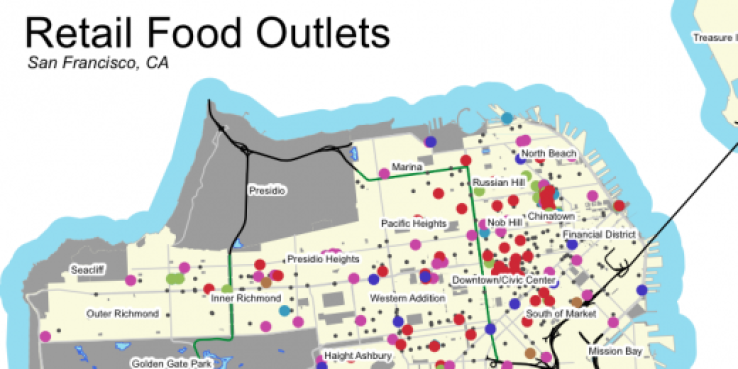San Francisco is known internationally for its celebration of food. The city can boast of top restaurants; nationally acclaimed grocers, bakers and butchers; a thriving fleet of food trucks; and bountiful farmers’ markets. But these food retailers are not distributed equally across the city. While San Franciscans in many neighborhoods can take a short walk or ride and find a greengrocer or supermarket, in some parts of the city, food access is more difficult.
The Department of Public Health has mapped the distribution of existing food retailers as part of its Sustainable Communities Index program. The results show that a number of neighborhoods — including Treasure Island, the Tenderloin, Hunters Point and Visitacion Valley, among others — have limited to no fresh food retail options.
While a full service grocery store is never more than a couple of miles away in a city as dense as San Francisco, the lack of quality, fresh food access within a convenient distance has both quality of life and public health impacts. Week to week, having to travel further for groceries – whether by foot, transit or car – takes up time and money. This travel is an additional cost that few San Franciscans would enjoy, but it’s especially difficult for low-income residents, many of whom live in neighborhoods with the least convenient access to fresh food.
In addition to the quality of life impacts, a neighborhood’s access to fresh food is also strongly connected to the health of the neighborhood. As Policy Link, a national non-profit organization pointed out in its Grocery Gap report, proximity to fresh food is strongly correlated with levels of obesity, diabetes and other diet-related diseases. Though recent articles in the Washington Post and New York Times have questioned how much the introduction of a new food retailer into a neighborhood positively impacts public health, food access advocates have in turn raised questions about the studies that are cited and pointed out that providing fresh food retail outlets is only one part (albeit an important part) of a campaign to improve diet-related public health.
Recognizing the importance of food access, Supervisor Eric Mar introduced legislation on September 25 to better coordinate the city’s efforts on the issue. The ordinance would establish a Healthy Food Retailer Incentives Program housed in the Office of Economic and Workforce Development. On the supply side of the equation, the program would be responsible for coordinating the city’s food access initiatives within a “one-stop shop” that links new or existing small food retail businesses (those less than 20,000 square feet in size) with incentives and technical support ranging from permit expediting and design assistance to grants and loans. The program is also structured to encourage convenience stores and small grocers to reduce the amount of shelf space they dedicate to tobacco and alcohol products. On the demand side, the legislation calls for the new program to pair its support for businesses with community engagement (like that piloted by the Food Guardians and the Southeast Food Access Working Group.)
Promoting healthy food retail has the additional potential benefit of providing economic development. Studies have shown that grocery stores and thriving corner stores can not only provide jobs but can also serve as anchor retailers that lift the fortunes of nearby businesses.
Even with a new coordinated focus from a city agency, addressing food access will not be easy. The changes will take money: retailers investing in new store designs and products, and consumers buying enough fresh food to make it pencil out for the retailer. And gauging the impact will take time. Supervisor Mar’s legislation has energized conversation about what the city can do to better address food access, and SPUR will continue to track the proposal’s development.
